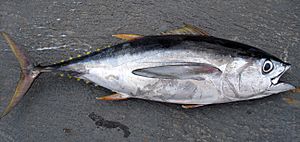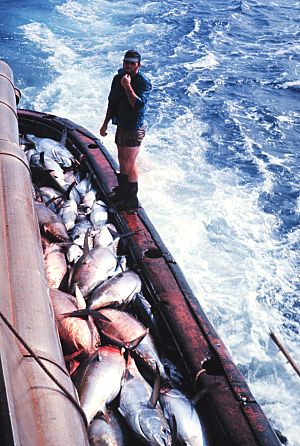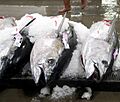Bigeye tuna facts for kids
Quick facts for kids Bigeye tuna |
|
|---|---|
 |
|
| Conservation status | |
| Scientific classification | |
| Synonyms | |
|
The Bigeye tuna (Thunnus obesus) is a type of tuna fish. It belongs to the wider mackerel family called Scombridae.
In Hawaiian, this fish is known as ʻahi. The yellowfin tuna is also called ʻahi.
Bigeye tuna live in the open parts of all tropical and mild oceans. However, you will not find them in the Mediterranean Sea.
Contents
What Bigeye Tuna Look Like
Bigeye tuna are large fish. They can grow up to 250 centimetres (98 inches) long. This is about 8 feet!
The heaviest one ever caught by an angler weighed 178 kilograms (392 pounds). That's like two grown-ups!
These fish have big heads and large eyes. Their pectoral fins are very long. They reach far back on their bodies.
How Bigeye Tuna's Body Works
Bigeye tuna have special bodies. This allows them to hunt for food in deep, cold waters. They can also handle waters with low oxygen.
Their blood is very good at picking up oxygen. This helps them survive in places where there isn't much oxygen.
They also have "heat exchangers" in their bodies. These help them keep warm in cold, deep water. When they swim up to warmer water, these exchangers let them warm up quickly.
Their eyes are also very good. They have a large lens that helps them see well in dim light. This is useful in the deep ocean.
Bigeye Tuna Life Cycle
Bigeye tuna can live for up to 16 years. Scientists figure this out by studying their ear bones, called otoliths.
They become ready to have babies (mature) when they are 2 to 4 years old. The size they reach maturity varies. In the eastern Pacific Ocean, they are about 135 cm long. In the western Pacific, they are 102–105 cm long.
Bigeye tuna usually spawn (lay eggs) throughout the year in tropical areas. In other places, they spawn when the water is warm enough, usually above 24 °C.
For example, in the northwestern tropical Atlantic, they spawn in June and July. In the Gulf of Guinea, they spawn in January and February. The Gulf of Guinea is the only known place where young tuna grow up in the Atlantic.
Bigeye Tuna Behavior
Daily Deep Dives
Bigeye tuna move up and down in the water each day. They usually swim down to deeper, cooler waters at sunrise. Then, they come back up to warmer, shallower waters at sunset.
During the day, they can dive very deep, sometimes 300–500 meters (about 1,000–1,600 feet). The water down there can be 20 °C colder than the surface!
They do this to control their body temperature. They swim back up to warmer water to warm themselves up.
The depth they spend most of their day at changes by location. This suggests they are looking for a perfect temperature (10-15 °C). This temperature zone is shallower in the eastern Pacific than in the western Pacific.
Scientists think these daily dives are linked to where their food moves. Bigeye tuna eat creatures that also move up and down in the water. They are often found near the sound scattering layer, which is a layer of small sea creatures.
Hanging Out with Objects
Bigeye tuna sometimes stay near underwater mountains (seamounts), buoys, or special floating devices called fish aggregating devices (FADs). When they do this, they tend to stay in the shallower surface waters.
They might stay near these objects for about 10 to 30 days. Fishermen use this behavior to catch tuna. About 27% of all tuna caught by purse seine nets in the western and central Pacific Ocean are caught near FADs.
How Bigeye Tuna Travel
Studies show that bigeye tuna can travel across entire oceans. But they can also stay in one area for a long time.
Some research suggests they migrate every year based on water temperature. For example, bigeye tuna in the central Pacific move from warmer subtropical waters in September to tropical waters in March.
What Bigeye Tuna Eat
Bigeye tuna mainly eat other fish that live near the surface or in mid-water. They also eat crustaceans (like crabs and shrimp) and cephalopods (like squid and octopus).
Commercial Fishing for Bigeye Tuna
In 2012, about 450,500 metric tonnes of bigeye tuna were caught by fishing boats worldwide.
Different groups manage tuna fishing in different oceans. These groups include:
- The Western and Central Pacific Fisheries Commission (WCPFC) for the Pacific Ocean.
- The Inter-American Tropical Tuna Commission (IATTC) for the eastern Pacific.
- The Indian Ocean Tuna Commission (IOTC) for the Indian Ocean.
- The International Commission for the Conservation of Atlantic Tunas (ICCAT) for the Atlantic Ocean.
These groups regularly check on bigeye tuna numbers. Currently, bigeye tuna are considered overfished in the western and central Pacific and eastern Pacific Oceans. They are close to being overfished in the Atlantic. In the Indian Ocean, they are not overfished.
Most bigeye tuna in the Pacific are caught using large nets called purse seines. In the Indian and Atlantic Oceans, they are mostly caught using longlines (long fishing lines with many hooks).
To protect the fish, these groups have rules. These include closing certain fishing areas or times, limiting how long boats can fish, and having observers on boats.
Threats to Bigeye Tuna
The number of bigeye tuna caught has dropped a lot in the last 50 years. This is mainly because of more industrial fishing.
Ocean warming also adds stress to these fish. Research shows that rising ocean temperatures are harming tuna in the Indian Ocean. Warmer water has led to less phytoplankton, which are tiny plants that form the base of the ocean food web.
Protecting Bigeye Tuna
Many guides that help people choose sustainable seafood suggest eating other types of tuna.
In 2010, Greenpeace International added bigeye tuna to its "seafood red list." This list includes fish that are often sold in stores but come from fishing practices that are not sustainable.
Images for kids
- Froese, Rainer, and Daniel Pauly, eds. (2006). "Thunnus obesus" in FishBase. January 2006 version.
See also
 In Spanish: Thunnus obesus para niños
In Spanish: Thunnus obesus para niños





